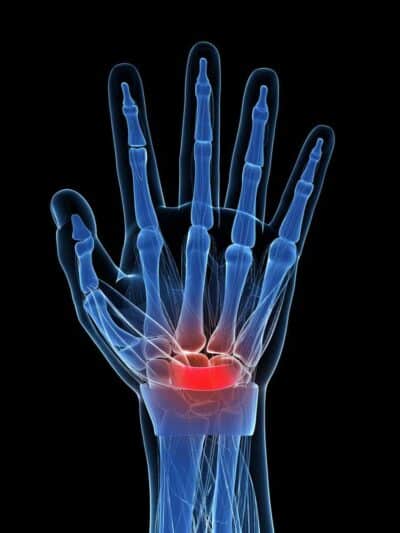
EMTs must use their hands and wrist to carry patients or move heavy objects for rescue operations. When the patient is critical for both time and condition, EMTs prioritize their patients and sometimes overuse their hands and wrists in lifting or taking a good grip of something. If this is done repeatedly, it can increase their risk for carpal tunnel syndrome. Anyone who works with their hands, especially repetitive work, should be aware of this condition.
Carpal tunnel syndrome (CTS) occurs when the median nerve gets squeezed as it goes through the wrist. The median nerve travels over the palmar surface of the carpal bones via the carpal tunnel. When inflammation or edema occurs in the carpal tunnel, the nerve gets compressed. This affects hand function due to pain and numbness in the fingers. The tingling, pain, or even loss of sensation affects the first three digits and the radial side of the fourth digit.
A wrist injury and repetitive use of wrists, as commonly seen in first responders, is a risk factor. Certain positions add pressure in the carpal tunnel and exacerbate symptoms. Complicated work situations may require holding the wrist in a non-ergonomic position that puts tension on the nerve or gripping an object tightly.
In a study conducted by Burt of the National Institute for Occupational Safety and Health, workplace physical factors, specifically hand activity level, are major risk factors for CTS. Other significant risk factors include sex, age, anatomic build, inflammatory conditions, acromegaly, and conditions that lead to fluid retention.
While EMTs may be at risk for developing this condition, they also may encounter patients experiencing symptoms of CTS. For proper diagnosis, taking note of a detailed history is a must. It’s important to find out when and how the injury started. Early on, the symptoms often worsen during sleep because people hyperflex their wrists while sleeping, putting more pressure on the median nerve.
On exam of the hands and wrists, there may be nothing obvious to see, but in advanced cases there can be muscle wasting seen in the hand as well as grip weakness. Provocative tests during an exam are used to confirm the presence of median nerve compression.
Phalen’s Sign is done by having the patient place palms together in a praying position, extending both wrists by 90 degrees and holding for 60 seconds. If positive, the patient will start to feel tingling (paresthesias) in the fingers innervated by the median nerve.
Another test is Tinels Sign – the patient experiences tingling over the affected fingers when the examiner taps on the median nerve at the patient’s wrist. Sometimes, a doctor may order electrodiagnostic testing to confirm the diagnosis if the findings of history and exam are not typical.
If measures aren’t taken to relieve pressure, CTS can result in permanent damage. Splinting and hand exercises upon early diagnosis will result in a greater chance that the condition won’t continue progressing. Corticosteroid injection or a short course of oral steroids is also a conservative approach in treating this disorder. For people who do not recover with the treatment, surgery will be the next option.
It’s important to do a complete history upon knowing the symptoms for any patient, and anyone working with their hands should be aware of this condition.
Carpal tunnel syndrome (CTS) occurs when the median nerve gets squeezed as it goes through the wrist. The median nerve travels over the palmar surface of the carpal bones via the carpal tunnel. When inflammation or edema occurs in the carpal tunnel, the nerve gets compressed. This affects hand function due to pain and numbness in the fingers. The tingling, pain, or even loss of sensation affects the first three digits and the radial side of the fourth digit.
A wrist injury and repetitive use of wrists, as commonly seen in first responders, is a risk factor. Certain positions add pressure in the carpal tunnel and exacerbate symptoms. Complicated work situations may require holding the wrist in a non-ergonomic position that puts tension on the nerve or gripping an object tightly.
In a study conducted by Burt of the National Institute for Occupational Safety and Health, workplace physical factors, specifically hand activity level, are major risk factors for CTS. Other significant risk factors include sex, age, anatomic build, inflammatory conditions, acromegaly, and conditions that lead to fluid retention.
While EMTs may be at risk for developing this condition, they also may encounter patients experiencing symptoms of CTS. For proper diagnosis, taking note of a detailed history is a must. It’s important to find out when and how the injury started. Early on, the symptoms often worsen during sleep because people hyperflex their wrists while sleeping, putting more pressure on the median nerve.
On exam of the hands and wrists, there may be nothing obvious to see, but in advanced cases there can be muscle wasting seen in the hand as well as grip weakness. Provocative tests during an exam are used to confirm the presence of median nerve compression.
Phalen’s Sign is done by having the patient place palms together in a praying position, extending both wrists by 90 degrees and holding for 60 seconds. If positive, the patient will start to feel tingling (paresthesias) in the fingers innervated by the median nerve.
Another test is Tinels Sign – the patient experiences tingling over the affected fingers when the examiner taps on the median nerve at the patient’s wrist. Sometimes, a doctor may order electrodiagnostic testing to confirm the diagnosis if the findings of history and exam are not typical.
If measures aren’t taken to relieve pressure, CTS can result in permanent damage. Splinting and hand exercises upon early diagnosis will result in a greater chance that the condition won’t continue progressing. Corticosteroid injection or a short course of oral steroids is also a conservative approach in treating this disorder. For people who do not recover with the treatment, surgery will be the next option.
It’s important to do a complete history upon knowing the symptoms for any patient, and anyone working with their hands should be aware of this condition.
Sources and More Information
Acupuncture Today, “Looking Beyond the Carpal Tunnel” by Douglas R. Briggs, DC, DIPL. AC. (IAMA), DAAPM, EMT https://www.acupuncturetoday.com/mpacms/at/article.php?id=32156
Mount Sinai, “Carpal Tunnel Syndrome” https://www.mountsinai.org/health-library/report/carpal-tunnel-syndrome
Medscape, “Carpal Tunnel Syndrome in Emergency Medicine” by Jonathan E Dangers, MD, MPH https://emedicine.medscape.com/article/822792-overview
Mount Sinai, “Carpal Tunnel Syndrome” https://www.mountsinai.org/health-library/report/carpal-tunnel-syndrome
Medscape, “Carpal Tunnel Syndrome in Emergency Medicine” by Jonathan E Dangers, MD, MPH https://emedicine.medscape.com/article/822792-overview


